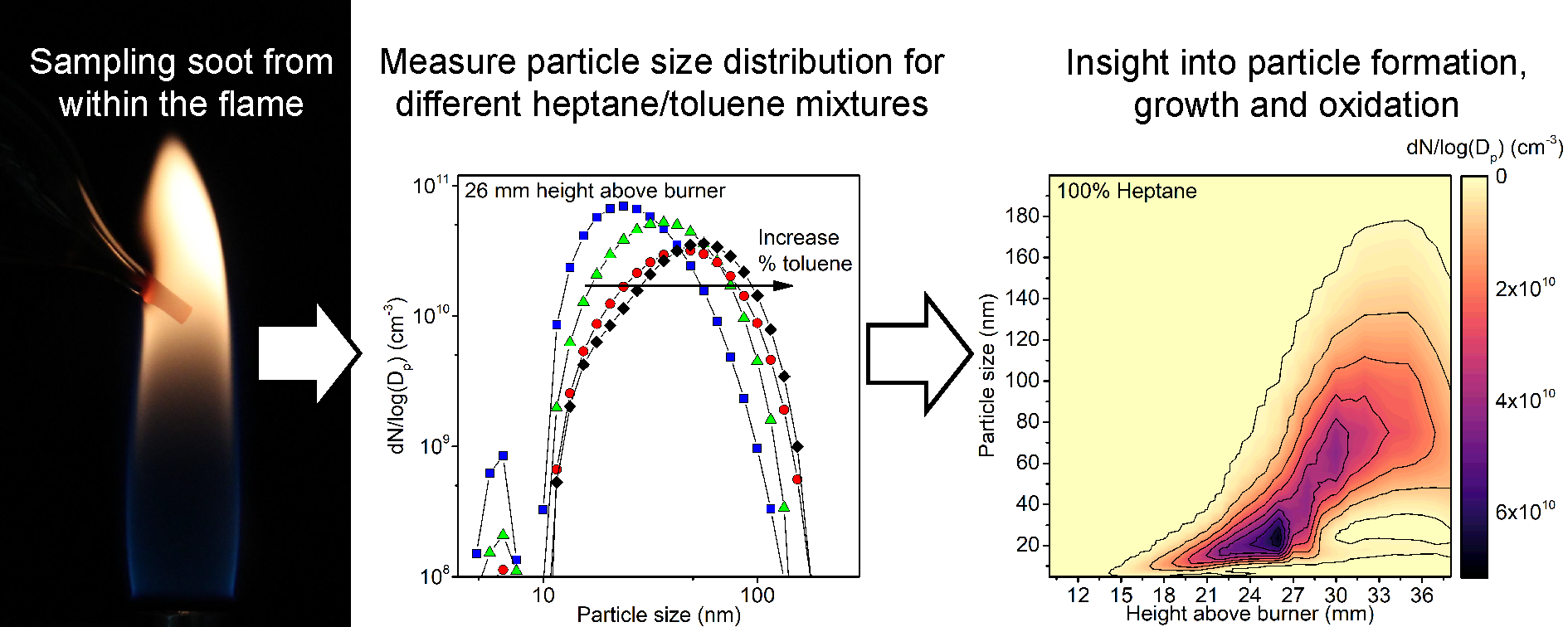Technical Report 206, c4e-Preprint Series, Cambridge
Evolution of the soot particle size distribution along the centreline of a n-heptane/toluene co-flow diffusion flame
Reference: Technical Report 206, c4e-Preprint Series, Cambridge, 2018
- Influence of heptane/toluene mixture on soot formation in a vapour-fed co-flow diffusion flame (Yale burner) was studied
- Newly developed quartz probe to take soot samples from within the flame
- Particle size distributions along the centreline were measured
- Toluene leads to earlier soot nucleation and growth to larger particles
- No influence of toluene on particle number densities
 A newly developed experimental set-up for studying liquid hydrocarbon combustion in the well-established Yale burner was used to investigate the correlation between fuel composition and its sooting propensity. Soot particle size distributions (PSDs) and flame temperatures along the centreline of an n-heptane/toluene co-flow diffusion flame are reported. The addition of toluene (0, 5, 10, and 15 mol%) to heptane moved soot inception to lower heights above the burner (HAB). The earlier inception extended the soot growth zone in the toluene-laden flames, leading to larger soot primary and agglomerate particles. Toluene addition had little influence on the maximum soot number density, indicating that increases in soot volume fraction can mainly be attributed to the observed increase in particle size. In order to explain the reasons for earlier soot inception in the presence of toluene, fuel decomposition and PAH formation were simulated in a perfectly-stirred reactor, with conditions corresponding to the fuel-rich regions at low HAB. Combining the experimental results with this simple model shows that one- and two-ring species form significantly faster in the presence of toluene, explaining the higher sooting propensity of aromatic fuels. The reported PSDs inside a vapour-fed diffusion flame are the first of their kind and provide a comprehensive dataset for future studies of combustion chemistry and soot particle models.
A newly developed experimental set-up for studying liquid hydrocarbon combustion in the well-established Yale burner was used to investigate the correlation between fuel composition and its sooting propensity. Soot particle size distributions (PSDs) and flame temperatures along the centreline of an n-heptane/toluene co-flow diffusion flame are reported. The addition of toluene (0, 5, 10, and 15 mol%) to heptane moved soot inception to lower heights above the burner (HAB). The earlier inception extended the soot growth zone in the toluene-laden flames, leading to larger soot primary and agglomerate particles. Toluene addition had little influence on the maximum soot number density, indicating that increases in soot volume fraction can mainly be attributed to the observed increase in particle size. In order to explain the reasons for earlier soot inception in the presence of toluene, fuel decomposition and PAH formation were simulated in a perfectly-stirred reactor, with conditions corresponding to the fuel-rich regions at low HAB. Combining the experimental results with this simple model shows that one- and two-ring species form significantly faster in the presence of toluene, explaining the higher sooting propensity of aromatic fuels. The reported PSDs inside a vapour-fed diffusion flame are the first of their kind and provide a comprehensive dataset for future studies of combustion chemistry and soot particle models.
Material from this preprint has been published in Combustion and Flame.
PDF (1.7 MB)



